Abstract
1. Acquisition of a two-way shuttle-box avoidance response is facilitated by ethanol. This facilitated acquisition of an avoidance response to ethanol was attenuated during withdrawal from chronic-ethanol diet intake (i.e. tolerance developed by ethanol). The deficit in the avoidance task after chronic ethanol treatment could be overcome by increasing the dose of ethanol. 2. Flumazenil, a benzodiazepine antagonist, also facilitated acquisition of the avoidance response in control rats. This response to flumazenil was significantly reduced during withdrawal from chronic-ethanol treatment. This reduced avoidance responding during withdrawal also could be overcome by increasing the dose of flumazenil. 3. The benzodiazepine-inverse agonist, RO 15-4513, produced a deficit in avoidance responding that was antagonized by both ethanol and flumazenil in a dose-related manner. 4. To determine whether flumazenil has the properties of a benzodiazepine agonist, it was established that, unlike the benzodiazepine chlordiazepoxide, flumazenil did not enhance the ethanol-induced deficit in the aerial righting reflex. Additionally, flumazenil blocked the action of chlordiazepoxide in this procedure, consistent with the benzodiazepine antagonist action of flumazenil. 5. Data collected are consistent with the hypothesis that an endogenous substance with the properties of a benzodiazepine-inverse agonist antagonizes the anticonflict actions of acutely administered ethanol during withdrawal from chronic-ethanol exposure.
Full text
PDF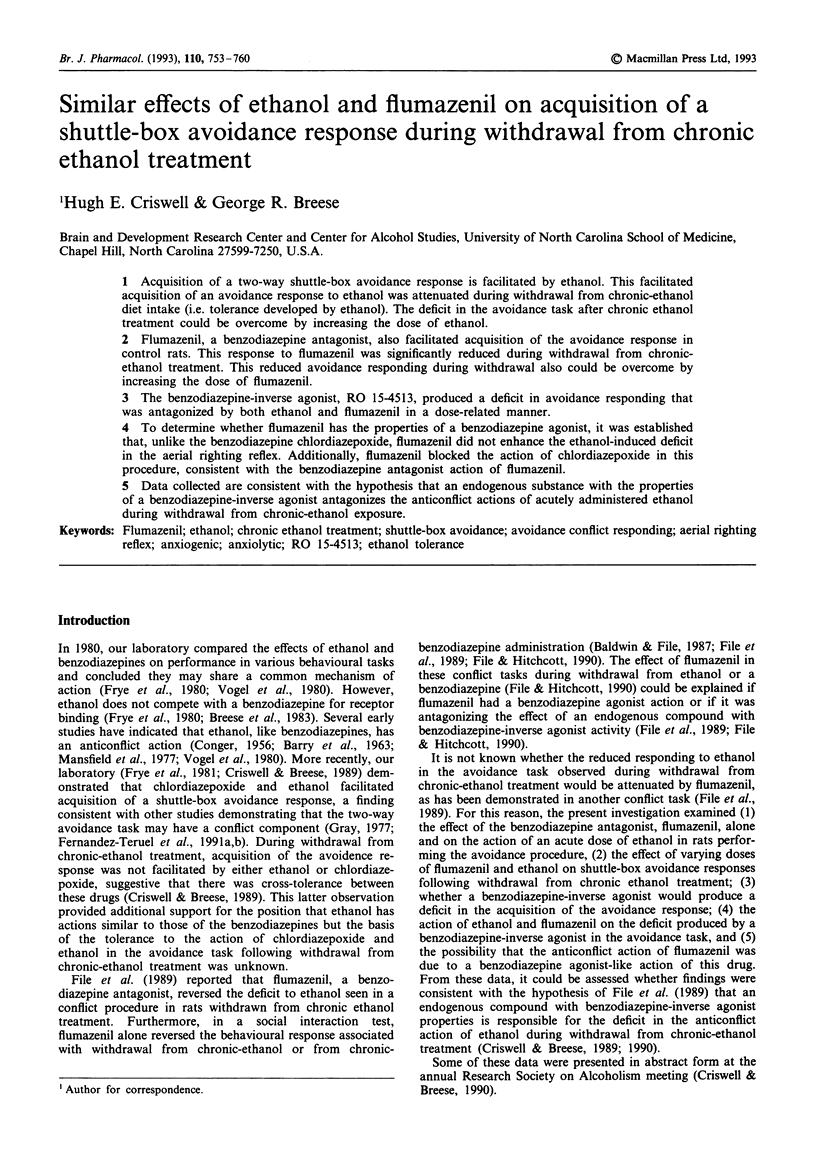
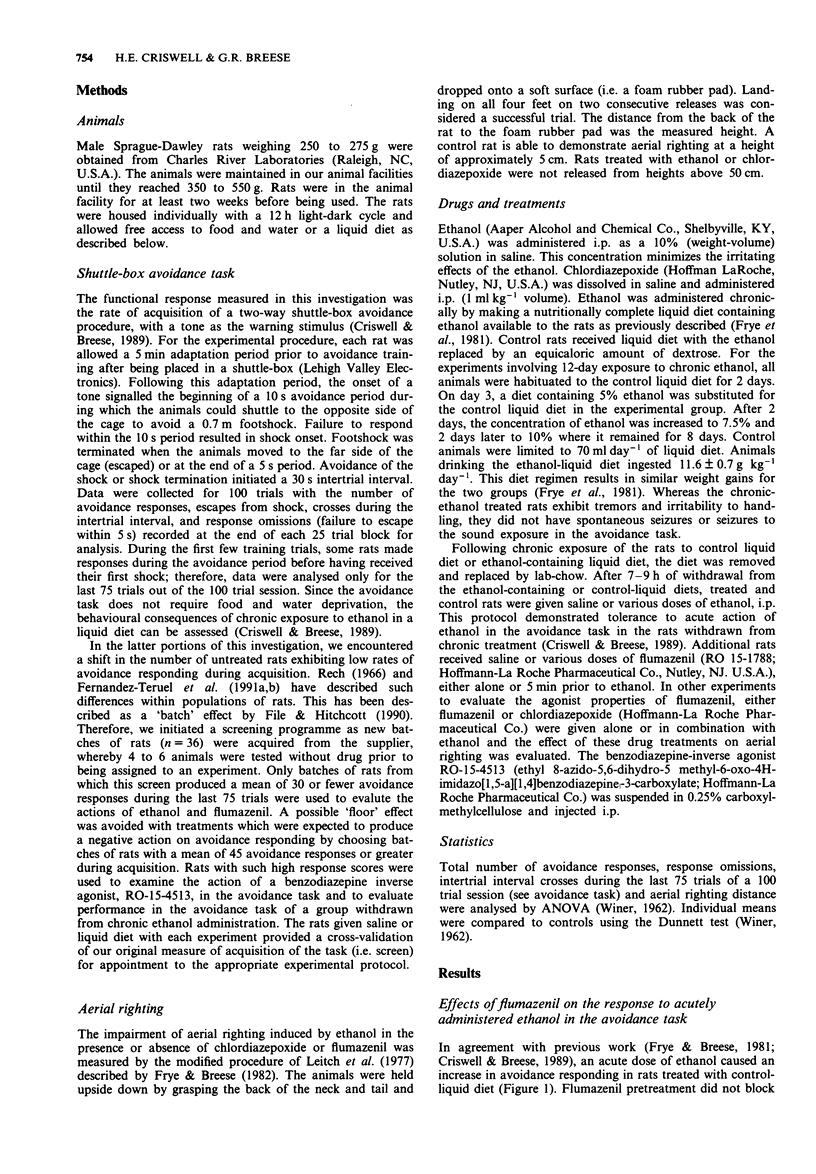
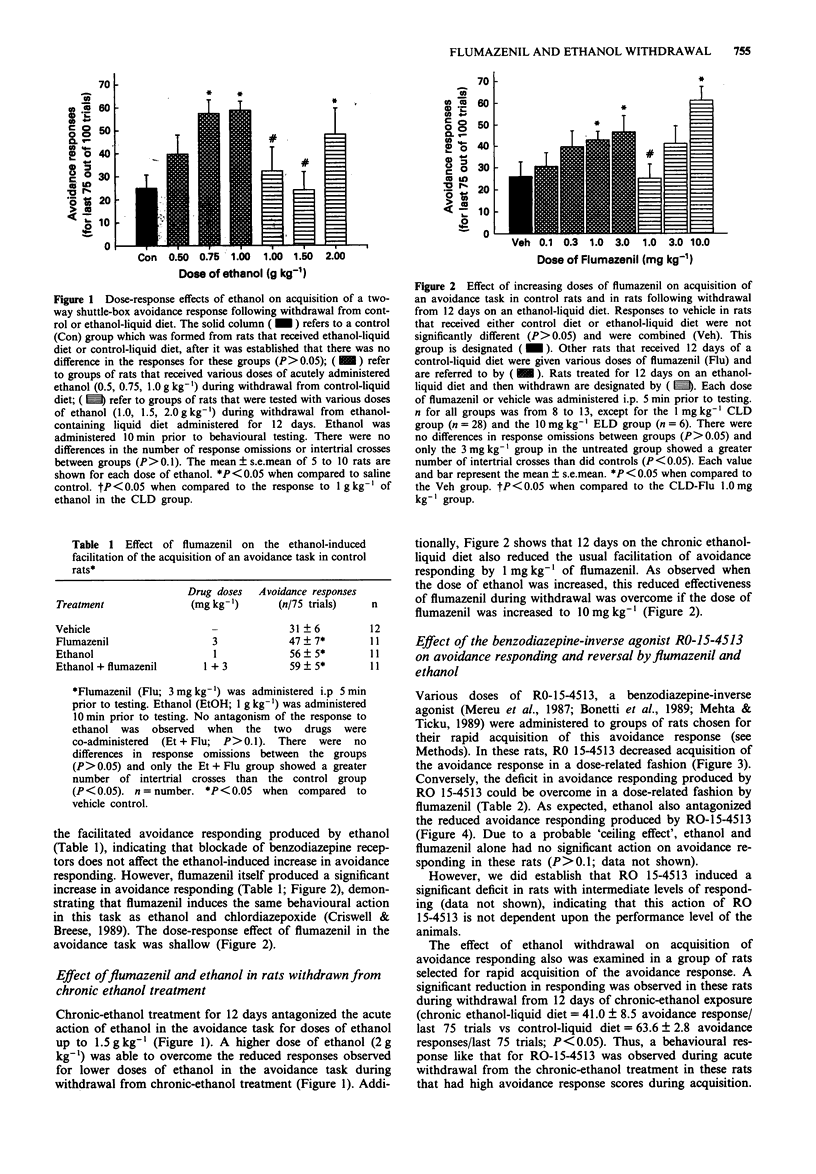
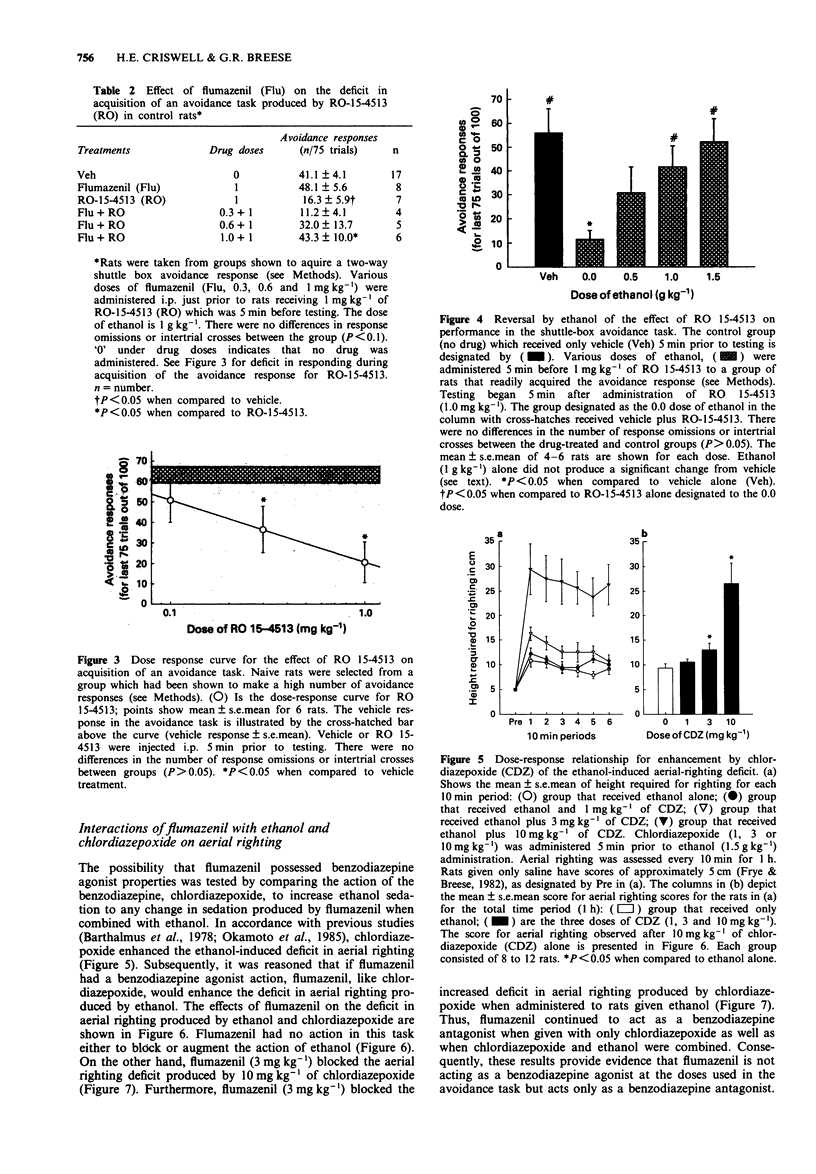
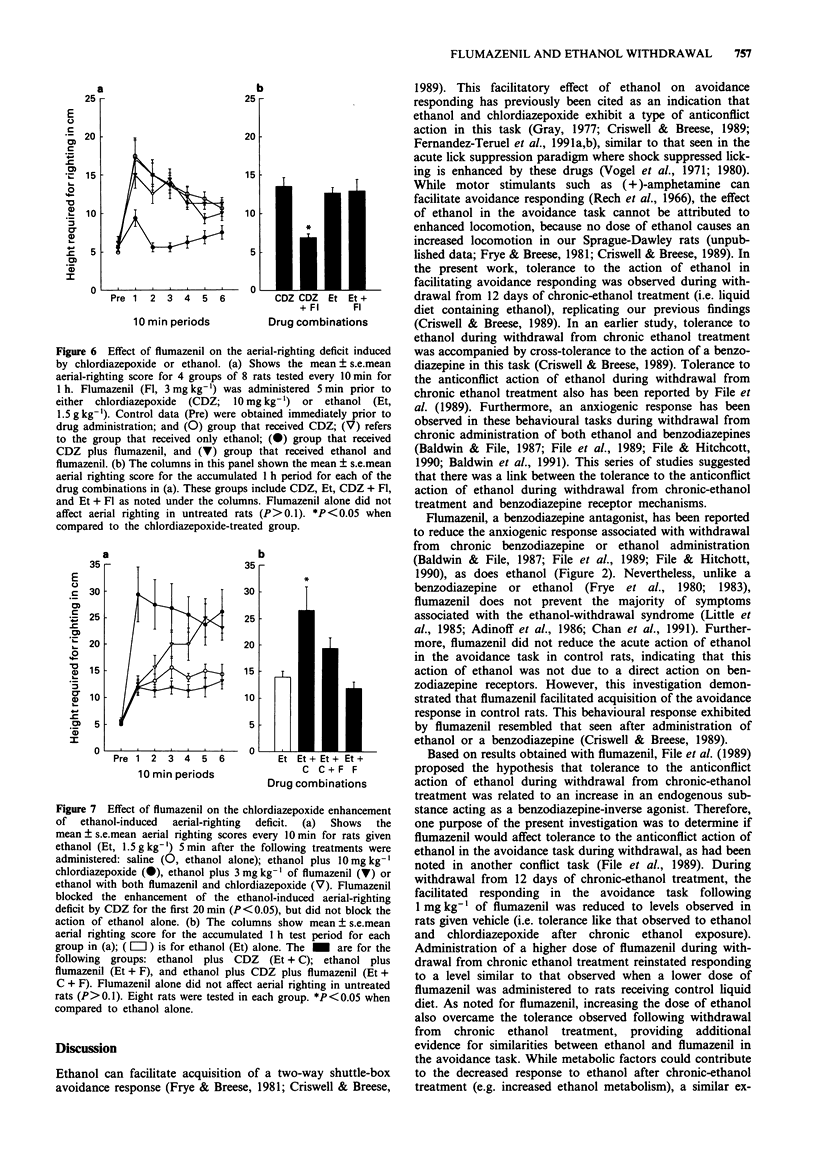
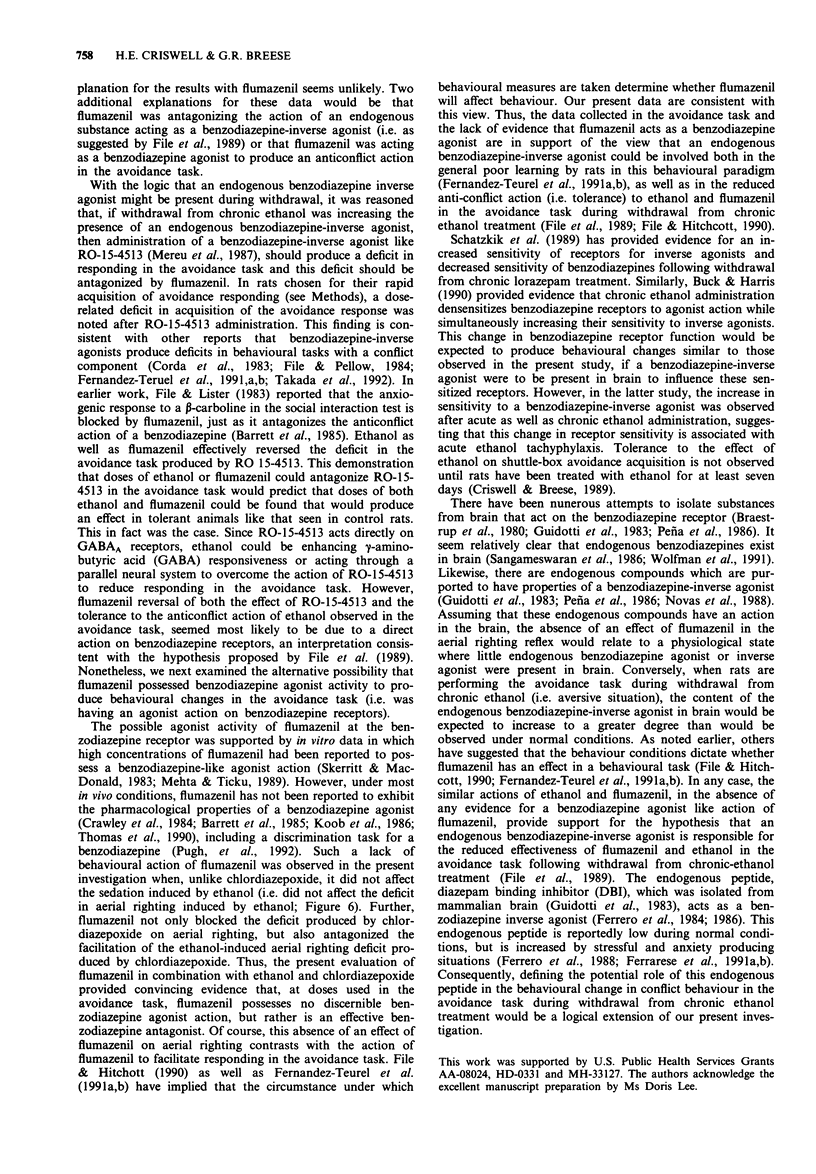
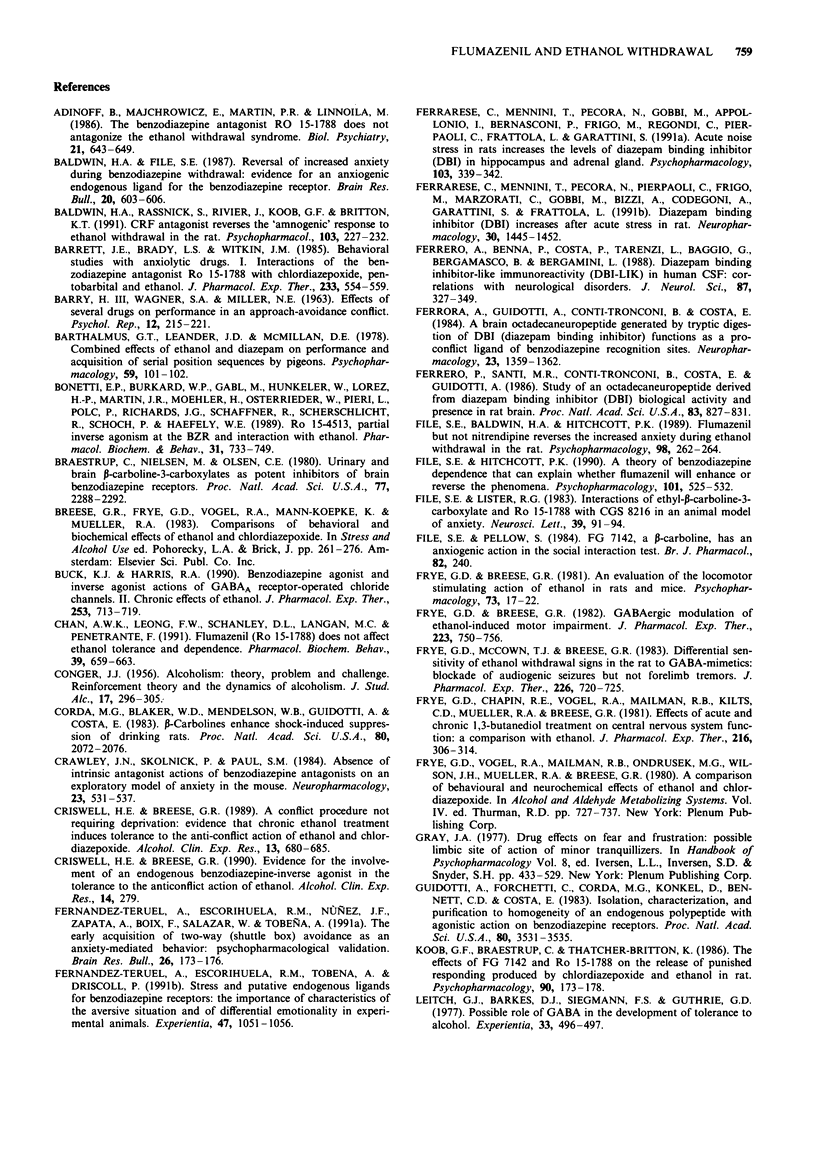
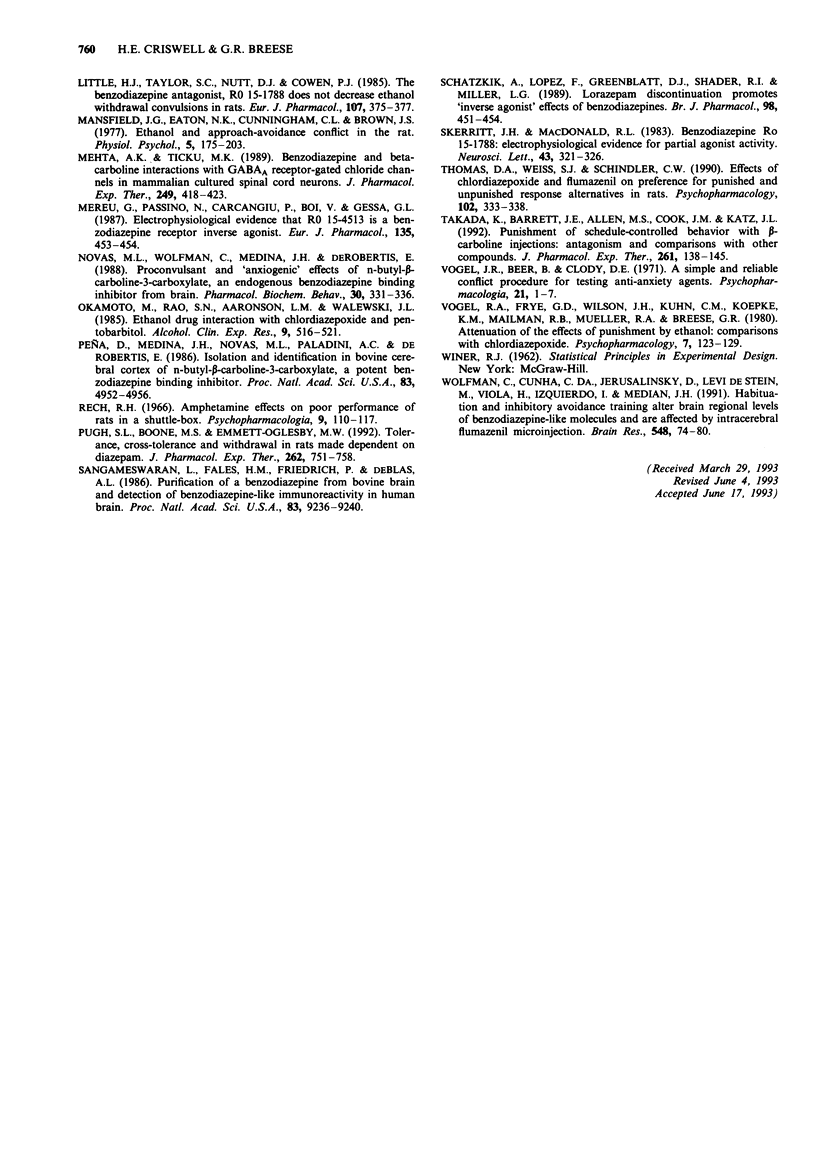
Selected References
These references are in PubMed. This may not be the complete list of references from this article.
- Adinoff B., Majchrowicz E., Martin P. R., Linnoila M. The benzodiazepine antagonist Ro 15-1788 does not antagonize the ethanol withdrawal syndrome. Biol Psychiatry. 1986 Jun;21(7):643–649. doi: 10.1016/0006-3223(86)90125-3. [DOI] [PubMed] [Google Scholar]
- Baldwin H. A., File S. E. Reversal of increased anxiety during benzodiazepine withdrawal: evidence for an anxiogenic endogenous ligand for the benzodiazepine receptor. Brain Res Bull. 1988 May;20(5):603–606. doi: 10.1016/0361-9230(88)90219-5. [DOI] [PubMed] [Google Scholar]
- Baldwin H. A., Rassnick S., Rivier J., Koob G. F., Britton K. T. CRF antagonist reverses the "anxiogenic" response to ethanol withdrawal in the rat. Psychopharmacology (Berl) 1991;103(2):227–232. doi: 10.1007/BF02244208. [DOI] [PubMed] [Google Scholar]
- Barrett J. E., Brady L. S., Witkin J. M. Behavioral studies with anxiolytic drugs. I. Interactions of the benzodiazepine antagonist Ro 15-1788 with chlordiazepoxide, pentobarbital and ethanol. J Pharmacol Exp Ther. 1985 Jun;233(3):554–559. [PubMed] [Google Scholar]
- Barthalmus G. T., Leander J. D., McMillan D. E. Combined effects of ethanol and diazepam on performance and acquisition of serial position sequences by pigeons. Psychopharmacology (Berl) 1978 Sep 15;59(1):101–102. doi: 10.1007/BF00428039. [DOI] [PubMed] [Google Scholar]
- Bonetti E. P., Burkard W. P., Gabl M., Hunkeler W., Lorez H. P., Martin J. R., Moehler H., Osterrieder W., Pieri L., Polc P. Ro 15-4513: partial inverse agonism at the BZR and interaction with ethanol. Pharmacol Biochem Behav. 1988 Nov;31(3):733–749. doi: 10.1016/0091-3057(88)90259-6. [DOI] [PubMed] [Google Scholar]
- Braestrup C., Nielsen M., Olsen C. E. Urinary and brain beta-carboline-3-carboxylates as potent inhibitors of brain benzodiazepine receptors. Proc Natl Acad Sci U S A. 1980 Apr;77(4):2288–2292. doi: 10.1073/pnas.77.4.2288. [DOI] [PMC free article] [PubMed] [Google Scholar]
- Buck K. J., Harris R. A. Benzodiazepine agonist and inverse agonist actions on GABAA receptor-operated chloride channels. II. Chronic effects of ethanol. J Pharmacol Exp Ther. 1990 May;253(2):713–719. [PubMed] [Google Scholar]
- CONGER J. J. Alcoholism: theory, problem and challenge. II. Reinforcement theory and the dynamics of alcoholism. Q J Stud Alcohol. 1956 Jun;17(2):296–305. [PubMed] [Google Scholar]
- Chan A. W., Leong F. W., Schanley D. L., Langan M. C., Penetrante F. Flumazenil (Ro15-1788) does not affect ethanol tolerance and dependence. Pharmacol Biochem Behav. 1991 Jul;39(3):659–663. doi: 10.1016/0091-3057(91)90143-p. [DOI] [PubMed] [Google Scholar]
- Corda M. G., Blaker W. D., Mendelson W. B., Guidotti A., Costa E. beta-Carbolines enhance shock-induced suppression of drinking in rats. Proc Natl Acad Sci U S A. 1983 Apr;80(7):2072–2076. doi: 10.1073/pnas.80.7.2072. [DOI] [PMC free article] [PubMed] [Google Scholar]
- Crawley J. N., Skolnick P., Paul S. M. Absence of intrinsic antagonist actions of benzodiazepine antagonists on an exploratory model of anxiety in the mouse. Neuropharmacology. 1984 May;23(5):531–537. doi: 10.1016/0028-3908(84)90026-1. [DOI] [PubMed] [Google Scholar]
- Criswell H. E., Breese G. R. A conflict procedure not requiring deprivation: evidence that chronic ethanol treatment induces tolerance to the anticonflict action of ethanol and chlordiazepoxide. Alcohol Clin Exp Res. 1989 Oct;13(5):680–685. doi: 10.1111/j.1530-0277.1989.tb00404.x. [DOI] [PubMed] [Google Scholar]
- Fernández-Teruel A., Escorihuela R. M., Núez J. F., Zapata A., Boix F., Salazar W., Tobeña A. The early acquisition of two-way (shuttle-box) avoidance as an anxiety-mediated behavior: psychopharmacological validation. Brain Res Bull. 1991 Jan;26(1):173–176. doi: 10.1016/0361-9230(91)90205-x. [DOI] [PubMed] [Google Scholar]
- Fernández-Teruel A., Escorihuela R. M., Tobeña A., Driscoll P. Stress and putative endogenous ligands for benzodiazepine receptors: the importance of characteristics of the aversive situation and of differential emotionality in experimental animals. Experientia. 1991 Oct 15;47(10):1051–1056. doi: 10.1007/BF01923340. [DOI] [PubMed] [Google Scholar]
- Ferrarese C., Mennini T., Pecora N., Gobbi M., Appollonio I., Bernasconi P., Frigo M., Regondi C., Pierpaoli C., Frattola L. Acute noise stress in rats increases the levels of diazepam binding inhibitor (DBI) in hippocampus and adrenal gland. Psychopharmacology (Berl) 1991;103(3):339–342. doi: 10.1007/BF02244287. [DOI] [PubMed] [Google Scholar]
- Ferrarese C., Mennini T., Pecora N., Pierpaoli C., Frigo M., Marzorati C., Gobbi M., Bizzi A., Codegoni A., Garattini S. Diazepam binding inhibitor (DBI) increases after acute stress in rat. Neuropharmacology. 1991 Dec;30(12B):1445–1452. doi: 10.1016/s0028-3908(11)80015-8. [DOI] [PubMed] [Google Scholar]
- Ferrero P., Benna P., Costa P., Tarenzi L., Baggio G., Bergamasco B., Bergamini L. Diazepam binding inhibitor-like immunoreactivity (DBI-LI) in human CSF. Correlations with neurological disorders. J Neurol Sci. 1988 Nov;87(2-3):327–349. doi: 10.1016/0022-510x(88)90257-2. [DOI] [PubMed] [Google Scholar]
- Ferrero P., Guidotti A., Conti-Tronconi B., Costa E. A brain octadecaneuropeptide generated by tryptic digestion of DBI (diazepam binding inhibitor) functions as a proconflict ligand of benzodiazepine recognition sites. Neuropharmacology. 1984 Nov;23(11):1359–1362. doi: 10.1016/0028-3908(84)90061-3. [DOI] [PubMed] [Google Scholar]
- Ferrero P., Santi M. R., Conti-Tronconi B., Costa E., Guidotti A. Study of an octadecaneuropeptide derived from diazepam binding inhibitor (DBI): biological activity and presence in rat brain. Proc Natl Acad Sci U S A. 1986 Feb;83(3):827–831. doi: 10.1073/pnas.83.3.827. [DOI] [PMC free article] [PubMed] [Google Scholar]
- File S. E., Baldwin H. A., Hitchcott P. K. Flumazenil but not nitrendipine reverses the increased anxiety during ethanol withdrawal in the rat. Psychopharmacology (Berl) 1989;98(2):262–264. doi: 10.1007/BF00444702. [DOI] [PubMed] [Google Scholar]
- File S. E., Hitchcott P. K. A theory of benzodiazepine dependence that can explain whether flumazenil will enhance or reverse the phenomena. Psychopharmacology (Berl) 1990;101(4):525–532. doi: 10.1007/BF02244232. [DOI] [PubMed] [Google Scholar]
- File S. E., Lister R. G. Interactions of ethyl-beta-carboline-3-carboxylate and Ro 15-1788 with CGS 8216 in an animal model of anxiety. Neurosci Lett. 1983 Aug 19;39(1):91–94. doi: 10.1016/0304-3940(83)90170-2. [DOI] [PubMed] [Google Scholar]
- Frye G. D., Breese G. R. GABAergic modulation of ethanol-induced motor impairment. J Pharmacol Exp Ther. 1982 Dec;223(3):750–756. [PMC free article] [PubMed] [Google Scholar]
- Frye G. D., Chapin R. E., Vogel R. A., Mailman R. B., Kilts C. D., Mueller R. A., Breese G. R. Effects of acute and chronic 1,3-butanediol treatment on central nervous system function: a comparison with ethanol. J Pharmacol Exp Ther. 1981 Feb;216(2):306–314. [PubMed] [Google Scholar]
- Frye G. D., McCown T. J., Breese G. R. Differential sensitivity of ethanol withdrawal signs in the rat to gamma-aminobutyric acid (GABA)mimetics: blockade of audiogenic seizures but not forelimb tremors. J Pharmacol Exp Ther. 1983 Sep;226(3):720–725. [PubMed] [Google Scholar]
- Guidotti A., Forchetti C. M., Corda M. G., Konkel D., Bennett C. D., Costa E. Isolation, characterization, and purification to homogeneity of an endogenous polypeptide with agonistic action on benzodiazepine receptors. Proc Natl Acad Sci U S A. 1983 Jun;80(11):3531–3535. doi: 10.1073/pnas.80.11.3531. [DOI] [PMC free article] [PubMed] [Google Scholar]
- Koob G. F., Braestrup C., Thatcher Britton K. The effects of FG 7142 and RO 15-1788 on the release of punished responding produced by chlordiazepoxide and ethanol in the rat. Psychopharmacology (Berl) 1986;90(2):173–178. doi: 10.1007/BF00181236. [DOI] [PubMed] [Google Scholar]
- Leitch G. J., Backes D. J., Siegman F. S., Guthrie G. D. Possible role of GABA in the development of tolerance to alcohol. Experientia. 1977 Apr 15;33(4):496–498. doi: 10.1007/BF01922232. [DOI] [PubMed] [Google Scholar]
- Little H. J., Taylor S. C., Nutt D. J., Cowen P. J. The benzodiazepine antagonist, Ro 15-1788 does not decrease ethanol withdrawal convulsions in rats. Eur J Pharmacol. 1985 Jan 8;107(3):375–377. doi: 10.1016/0014-2999(85)90265-1. [DOI] [PubMed] [Google Scholar]
- Mehta A. K., Ticku M. K. Benzodiazepine and beta-carboline interactions with GABAA receptor-gated chloride channels in mammalian cultured spinal cord neurons. J Pharmacol Exp Ther. 1989 May;249(2):418–423. [PubMed] [Google Scholar]
- Mereu G., Passino N., Carcangiu P., Boi V., Gessa G. L. Electrophysiological evidence that Ro 15-4513 is a benzodiazepine receptor inverse agonist. Eur J Pharmacol. 1987 Mar 31;135(3):453–454. doi: 10.1016/0014-2999(87)90700-x. [DOI] [PubMed] [Google Scholar]
- Novas M. L., Wolfman C., Medina J. H., de Robertis E. Proconvulsant and 'anxiogenic' effects of n-butyl beta carboline-3-carboxylate, an endogenous benzodiazepine binding inhibitor from brain. Pharmacol Biochem Behav. 1988 Jun;30(2):331–336. doi: 10.1016/0091-3057(88)90463-7. [DOI] [PubMed] [Google Scholar]
- Okamoto M., Rao S. N., Aaronson L. M., Walewski J. L. Ethanol drug interaction with chlordiazepoxide and pentobarbital. Alcohol Clin Exp Res. 1985 Dec;9(6):516–521. doi: 10.1111/j.1530-0277.1985.tb05595.x. [DOI] [PubMed] [Google Scholar]
- Ondrusek M. G., Kilts C. D., Frye G. D., Mailman R. B., Mueller R. A., Breese G. R. Behavioral and biochemical studies of the scopolamine-induced reversal of neuroleptic activity. Psychopharmacology (Berl) 1981;73(1):17–22. doi: 10.1007/BF00431093. [DOI] [PubMed] [Google Scholar]
- Peña C., Medina J. H., Novas M. L., Paladini A. C., De Robertis E. Isolation and identification in bovine cerebral cortex of n-butyl beta-carboline-3-carboxylate, a potent benzodiazepine binding inhibitor. Proc Natl Acad Sci U S A. 1986 Jul;83(13):4952–4956. doi: 10.1073/pnas.83.13.4952. [DOI] [PMC free article] [PubMed] [Google Scholar]
- Pugh S. L., Boone M. S., Emmett-Oglesby M. W. Tolerance, cross-tolerance and withdrawal in rats made dependent on diazepam. J Pharmacol Exp Ther. 1992 Aug;262(2):751–758. [PubMed] [Google Scholar]
- Rech R. H. Amphetamine effects on poor performance of rats in a shuttle-box. Psychopharmacologia. 1966;9(2):110–117. doi: 10.1007/BF00404716. [DOI] [PubMed] [Google Scholar]
- Sangameswaran L., Fales H. M., Friedrich P., De Blas A. L. Purification of a benzodiazepine from bovine brain and detection of benzodiazepine-like immunoreactivity in human brain. Proc Natl Acad Sci U S A. 1986 Dec;83(23):9236–9240. doi: 10.1073/pnas.83.23.9236. [DOI] [PMC free article] [PubMed] [Google Scholar]
- Schatzki A., Lopez F., Greenblatt D. J., Shader R. I., Miller L. G. Lorazepam discontinuation promotes 'inverse agonist' effects of benzodiazepines. Br J Pharmacol. 1989 Oct;98(2):451–454. doi: 10.1111/j.1476-5381.1989.tb12617.x. [DOI] [PMC free article] [PubMed] [Google Scholar]
- Skerritt J. H., Macdonald R. L. Benzodiazepine Ro 15-1788: electrophysiological evidence for partial agonist activity. Neurosci Lett. 1983 Dec 30;43(2-3):321–326. doi: 10.1016/0304-3940(83)90208-2. [DOI] [PubMed] [Google Scholar]
- Takada K., Barrett J. E., Allen M. S., Cook J. M., Katz J. L. Punishment of schedule-controlled behavior with beta-carboline injections: antagonism and comparisons with other compounds. J Pharmacol Exp Ther. 1992 Apr;261(1):138–145. [PubMed] [Google Scholar]
- Thomas D. A., Weiss S. J., Schindler C. W. Effects of chlordiazepoxide and flumazenil on preference for punished and unpunished response alternatives in rats. Psychopharmacology (Berl) 1990;102(3):333–338. doi: 10.1007/BF02244100. [DOI] [PubMed] [Google Scholar]
- Vogel J. R., Beer B., Clody D. E. A simple and reliable conflict procedure for testing anti-anxiety agents. Psychopharmacologia. 1971;21(1):1–7. doi: 10.1007/BF00403989. [DOI] [PubMed] [Google Scholar]
- Vogel R. A., Frye G. D., Wilson J. H., Kuhn C. M., Koepke K. M., Mailman R. B., Mueller R. A., Breese G. R. Attenuation of the effects of punishment by ethanol: comparisons with chlordiazepoxide. Psychopharmacology (Berl) 1980;71(2):123–129. doi: 10.1007/BF00434399. [DOI] [PubMed] [Google Scholar]
- Wolfman C., Da Cunha C., Jerusalinsky D., Levi de Stein M., Viola H., Izquierdo I., Medina J. H. Habituation and inhibitory avoidance training alter brain regional levels of benzodiazepine-like molecules and are affected by intracerebral flumazenil microinjection. Brain Res. 1991 May 10;548(1-2):74–80. doi: 10.1016/0006-8993(91)91108-d. [DOI] [PubMed] [Google Scholar]


